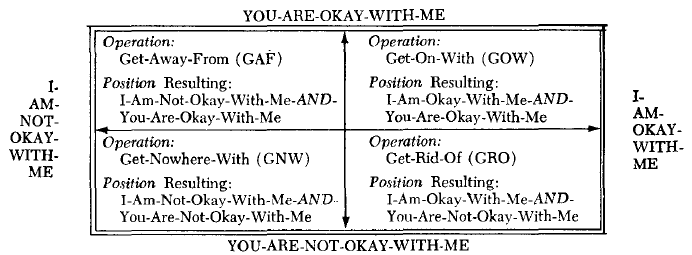Free Handout Download
Life Scripts in Transactional Analysis

Forming part of the vocabulary of transactional analysis (Berne, 1961), our life script (Berne, 1972 p.46) is an unconscious pathway created in childhood, reinforced by our parents, and strengthened with evidence sought throughout life ensuring our beliefs are justified.
Life Scripts in Transactional Analysis
Berne (1972 p.136) identifies seven elements of script apparatus in order to understand how script works:
Payoff or curse describes messages from our parents or parental figures on how we will end up.
Injunctions or stoppers according to Berne (1972 p.139) are “the most important part of the script apparatus, and varies in intensity”, and defines it as “A prohibition or negative command from a parent”.
Counterscript is communicated later in li fe in which Berne (1972 p. 489) defines as: “A possible life plan based on parental precepts.”
Modelling and copying behaviour seen and heard contributes to how we fulfil our script and according to Berne, programs or patterns are present before the age of six the majority of the time.
Provocation or come-on encourages and confirms our script belief, coming from the demon in the Parent.
The Demon is an internal unpredictable impulsive voice in which Berne compares to the concept of Freud’s (1989 [1940]) ‘id’, although the reasoning why is unclear as he never went into detail to explain.
Antiscript, Spell-breaker or Internal Release, is a form of self-destruction of script by the trigger of a pre-set real, or fantasy event made up in our minds, which frees the person from unhelpful script elements.
In early childhood, and arguably even in the womb before we make our first appearance or entrance into the world, we are storing decisions within our mind and our body.
When we move into script, somatic feelings stored within our muscles and nervous system give out clues and signs to those around us and ourselves.
Immediacy is sensing a hunch of what is going on in the here and now and is a treasured counselling tool.
Noticing these signs are not only valuable for us in order to learn how to change, but as counsellors within the therapeutic alliance, it allows us to spot what is going on with the client.
Acutely observing someone’s breathing patterns, agitation or tonality of voice may indicate script signals.
Widdowson (2010 p.157) gathers information from clients by asking:
Life Scripts in Transactional Analysis
A theory that arose from life scripts is the notion of four life positions (Berne, 1962) . These are:
There are different ways of diagramming these positions. Ernst’s grid (1971) is one of the most popular and useful.
Named the ‘OK Corral‘, Ernst’s grid displays within four windows our positive and negative views of the world, those around us and ourselves.
Although having a preferred position we revert to, people will move around the grid depending on influences and experiences from situations that life throws along the way.

The ‘I’m OK, You’re OK’ person gets on with others and may be described as confident and contented within their work, home and life as a whole, mutually respecting others thoughts and opinions, even if they disagree with them.
The ‘I’m OK, You’re not OK’ person has been decided on within the second or third year of life. They tend to be angry, showing hostility, viewing others as incompetent and not to be trusted from a superior position, belittling them with competitiveness. Without much conscience, they view faults within situations are due to others, and not themselves.
Unhappy, inadequate and perhaps useless are words that may describe the ‘I’m not OK, you’re OK’ life position. Lack of self-belief, often putting themselves down by undervaluing their skills or contributions in life. This person is eager and willing to please others in order to gain approval but find difficult to acknowledge such recognition once gained.
With the I’m not OK, you’re not OK position, a sense of abandonment is felt during the first year with strokes either few and far between or non-existent which may lead to confusion and a sense of pointlessness, so simply stops trying to bother at all. Depression and withdrawal can conclude with mental institutionalisation.
As soon as the process of script writing starts, we write conclusions about the world around us, ourselves and others. The basic framework of our scripts are born from messages, influences and interactions with our parents and parental figures via verbal and non-verbal messages.
Goulding and Goulding (1976) identified 12 main injunctions. These are:
These are verbal script messages from my parents’ Parent, and stored in my Parent as a child. They work in compliance with my injunctions and re-enforced non-verbally.
Also called counterscript (Berne, 1972), they can re-enforce and contradict the injunctions with driver (Kahler, 1974) messages influencing thinking, feeling and behaviour.
There are five drivers in particular used as a defence mechanism and have the most meaningful role carried around responding to the demands of our counterscripts. The favourite or primary driver is most likely to show itself when stressed or anxious.
Life Scripts in Transactional Analysis
Berne, E. (1961) Transactional Analysis in Psychotherapy. New York. Grove Press.
Berne, E. (1962, 1976) ‘Classification of positions’, Transactional Analysis Bulletin, vol. 1, 3: p. 23
Berne, E. (1972) What Do You Say After You Say Hello. New York. Grove Press.
Ernst, F (1971) ‘The OK Corral: the grid to get-on-with’ Transactional Analysis Journal, vol. 1, 4: p.p. 231-40
Freud, S. (1989 [1940]) An Outline of Psycho-Analysis (trans. J. Strachey), London, W. W. Norton & Company.
Goulding, R. and Goulding, M. (1976) ‘Injunctions, Decisions and Redecisions’, Transactional Analysis Journal, vol. 6, 1: pp. 41-48
Kahler, T. Ph.D. and Hedges Capers, Div. M., LHD., (1974) “The Miniscript”, Transactional Analysis Journal, vol. 4 1: pp. 26-42.
Steiner, C. M. (1966) ‘Script and Counterscript’ Transactional Analysis Bulletin, vol.18
Widdowson, M. (2010) Transactional Analysis: 100 Key Points & Techniques. London and New York, Routledge.
Notice any broken link or issues with this resource? Kindly let us know by email
Email us